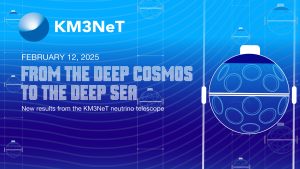KM3NeT webinar

5 February 2025 – We have exciting news to report!
Please join us Wednesday, 12 February at 4:50 p.m. CET to know more.
The webinar will be streamed on the KM3NeT YouTube channel: https://www.youtube.com/live/2jgyZlBpkl8?si=qSwkKHynETOZ_xbA
Additional information can be found here.

